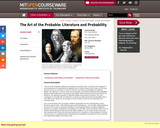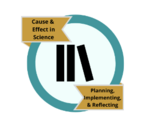
This document expounds on the relationship between the Nature of Science and new science standards.
- Subject:
- Science
- Material Type:
- Reading
- Provider:
- Next Generation Science
- Date Added:
- 07/07/2023

This document expounds on the relationship between the Nature of Science and new science standards.

The Art of the Probable" addresses the history of scientific ideas, in particular the emergence and development of mathematical probability. But it is neither meant to be a history of the exact sciences per se nor an annex to, say, the Course 6 curriculum in probability and statistics. Rather, our objective is to focus on the formal, thematic, and rhetorical features that imaginative literature shares with texts in the history of probability. These shared issues include (but are not limited to): the attempt to quantify or otherwise explain the presence of chance, risk, and contingency in everyday life; the deduction of causes for phenomena that are knowable only in their effects; and, above all, the question of what it means to think and act rationally in an uncertain world. Our course therefore aims to broaden students’ appreciation for and understanding of how literature interacts with--both reflecting upon and contributing to--the scientific understanding of the world. We are just as centrally committed to encouraging students to regard imaginative literature as a unique contribution to knowledge in its own right, and to see literary works of art as objects that demand and richly repay close critical analysis. It is our hope that the course will serve students well if they elect to pursue further work in Literature or other discipline in SHASS, and also enrich or complement their understanding of probability and statistics in other scientific and engineering subjects they elect to take.

This microcredential is the third in the Cause and Effect in Science microcredential stack. This stack, when completed, meets Requirement Area #4 of the Elementary Science Endorsement. Through this microcredential applicants demonstrate understanding of how to prepare and enact three-dimensional science instruction that is based on authentic phenomena and problems and supports the development of students’ conceptual science understanding and scientific literacy.

This lesson introduces the concept of cause and effect with Trinka Hakes Noble's books about Jimmy and his boa constrictor. Each lesson begins with the teacher reading a new story about Jimmy and his boa and the chaos they bring to each place they visit. Class discussions about each event and its cause are followed by tasks for the students to help illustrate understanding of the concept. Students create cause-and-effect pictures, puzzles, and flow charts as they explore the genre. As a culminating activity, students write their own book with causes and effects, which are assessed with a rubric.

This microcredential is the first in the Cause and Effect in Science microcredential stack. This stack, when completed, meets Requirement Area #4 of the Elementary Science Endorsement. Through this microcredential, applicants identify causal relationships and mechanisms to explain changes and predict phenomena in life science, physical science, and earth and space science concepts through planning and carrying out investigations.

This microcredential is the second in the Cause and Effect in Science microcredential stack. This stack, when completed, meets Requirement Area #4 of the Elementary Science Endorsement. Through this microcredential, applicants demonstrate the ability to ask and refine scientific questions that lead to descriptions and explanations of causal relationships that can be empirically tested as a way to understand the natural world.

This microcredential is the fourth in the Cause and Effect in Science microcredential stack. This stack, when completed, meets Requirement Area #4 of the Elementary Science Endorsement. Through this microcredential applicants demonstrate an ability to promote effective and equitable science instruction both in personal practice and in the science education community.

This microcredential is the first in the Classroom Practice in Science microcredential stack. This stack, when completed, meets Requirement Area #6 of the Elementary Science Endorsement. Through this microcredential, applicants identify how crosscutting concepts and disciplinary core ideas support sensemaking.

This microcredential is the second in the Classroom Practice in Science microcredential stack. This stack, when completed, meets Requirement Area #6 of the Elementary Science Endorsement. Through this microcredential applicants demonstrate understanding of how to prepare and enact three-dimensional science instruction that is based on authentic phenomena and problems and supports the development of students’ conceptual science understanding and scientific literacy.

This microcredential is the third in the Classroom Practice in Science microcredential stack. This stack, when completed, meets Requirement Area #6 of the Elementary Science Endorsement. Through this microcredential applicants demonstrate an ability to promote effective and equitable science instruction both in personal practice and in the science education community.

This microcredential is the first in the Matter and Energy in Science microcredential stack. This stack, when completed, meets Requirement Area #3 of the Elementary Science Endorsement. Through this microcredential applicants demonstrate an understanding of matter and energy in systems through developing and using models.

This microcredential is the second in the Matter and Energy in Science microcredential stack. This stack, when completed, meets Requirement Area #3 of the Elementary Science Endorsement. Through this microcredential educators demonstrate an understanding of science discourse by critiquing and revising models of matter and energy.

This microcredential is the third in the Matter and Energy in Science microcredential stack. This stack, when completed, meets Requirement Area #3 of the Elementary Science Endorsement. Through this microcredential applicants demonstrate understanding of how to prepare and enact three-dimensional science instruction that is based on authentic phenomena and problems and supports the development of students’ conceptual science understanding and scientific literacy.

This microcredential is the fourth in the Matter and Energy in Science microcredential stack. This stack, when completed, meets Requirement Area #3 of the Elementary Science Endorsement. Through this microcredential applicants demonstrate an ability to promote effective and equitable science instruction both in personal practice and in the science education community.

This microcredential is the first in the Nature of Science and Engineering microcredential stack. This stack, when completed, meets Requirement Area #1 of the Elementary Science Endorsement. Through this microcredential, educators: Demonstrate conceptual understandings of the key aspects of the Nature of Science. Identify discourse and reflective experiences of the Nature of Science in order to explain how scientific knowledge is developed and communicated, used to influence social and economic decisions, and improves life. Explain the history of science as a valuable context to understand the structure of and access to science learning.

This microcredential is the second in the Nature of Science and Engineering microcredential stack. This stack, when completed, meets Requirement Area #1 of the Elementary Science Endorsement. Through this microcredential, educators: Demonstrate conceptual understandings of the key aspects of the Nature of Engineering, and Demonstrate foundational understandings of how the Nature of Science in concert with the Nature of Engineering influences individual and societal decision making and approaches to scientific literacy.

This microcredential is the third in the Nature of Science and Engineering microcredential stack. This stack, when completed, meets Requirement Area #1 of the Elementary Science Endorsement. Through this microcredential, educators: Demonstrate how the Nature of Science connects with three-dimensional science instruction and Prepare to enact three-dimensional science instruction that is based on authentic phenomena and problems and supports the development of students’ conceptual science understanding and scientific literacy.

This microcredential is the Fourth in the Nature of Science and Engineering microcredential stack. This stack, when completed, meets Requirement Area #1 of the Elementary Science Endorsement. Through this microcredential, educators demonstrate an ability to promote effective and equitable science instruction both in personal practice and in the science education community.

This microcredential is the first in the Stability and Change in Science microcredential stack. This stack, when completed, meets Requirement Area #5 of the Elementary Science Endorsement. Through this microcredential applicants demonstrate understanding of how changes occur in natural systems and construct explanations and arguments supported by evidence of how systems in dynamic equilibrium are stable due to a balance of feedback mechanisms within the system.

This microcredential is the second in the Stability and Change in Science microcredential stack. This stack, when completed, meets Requirement Area #5 of the Elementary Science Endorsement. Through this microcredential applicants demonstrate understanding of how changes occur as natural systems interact through constructing explanations, and improving them through argumentation. Additionally, educators demonstrate an understanding that change in systems occurs in differing temporal scales (change can happen suddenly or over a long period of time), spatial scales (changes occur based on the shape, orientation, location, direction or trajectory), and scales of magnitude (small changes can lead to big effects or big changes cause many small effects).